Sumer
Sumer (/ˈsuːmər/)[note 1] is the earliest known civilization in the historical region of southern Mesopotamia (now southern Iraq), emerging during the Chalcolithic and early Bronze Ages between the sixth and fifth millennium BC. It is also one of the first civilizations in the world, along with Ancient Egypt, Norte Chico, Minoan civilization, Ancient China, Mesoamerica and the Indus Valley. Living along the valleys of the Tigris and Euphrates, Sumerian farmers grew an abundance of grain and other crops, the surplus from which enabled them to form urban settlements. Prehistoric proto-writing dates back before 3000 BC. The earliest texts come from the cities of Uruk and Jemdet Nasr, and date to between c. 3500 and c. 3000 BC.[1]
  Sumer General location on a modern map, and main cities of Sumer with ancient coastline. The coastline was nearly reaching Ur in ancient times. | |
| Geographical range | Mesopotamia, Near East, Middle East |
|---|---|
| Period | Late Neolithic, Middle Bronze Age |
| Dates | c. 4500 – c. 1900 BC |
| Preceded by | Ubaid period |
| Followed by | Akkadian Empire |
Name
The term "Sumer" (𒋗𒈨𒊒, Sumerian: eme.gi7, Akkadian: Šumeru) is the name given to the land of the "Sumerians", the ancient non-Semitic-speaking inhabitants of southern Mesopotamia, by their successors the East Semitic-speaking Akkadians.[6][7][8] The Sumerians themselves referred to their land as "Kiengir", the "Country of the noble lords" (𒆠𒂗𒄀, ki-en-gi(-r), lit. "country" + "lords" + "noble") as seen in their inscriptions.[6][9][10]
The origin of the Sumerians is not known, but the people of Sumer referred to themselves as "Black Headed Ones" or "Black-Headed People"[6][11][12][13] (𒊕 𒈪, saĝ-gíg, lit. "head" + "black", or 𒊕 𒈪 𒂵, saĝ-gíg-ga or sang-ngiga phonetically /saŋ ɡi ɡa/, lit. "head" + "black" + "carry").[2][3][4][5] For example, the Sumerian king Shulgi described himself as "the king of the four quarters, the pastor of the black-headed people".[14] The Akkadians also called the Sumerians "black-headed people", or tsalmat-qaqqadi, in the Semitic Akkadian language.[3][4]
The Akkadian word Šumer may represent the geographical name in dialect, but the phonological development leading to the Akkadian term šumerû is uncertain.[15] Hebrew שנער Šin`ar, Egyptian Sngr, and Hittite Šanhar(a), all referring to southern Mesopotamia, could be western variants of Sumer.[15]
Origins
Most historians have suggested that Sumer was first permanently settled between c. 5500 and 4000 BC by a West Asian people who spoke the Sumerian language (pointing to the names of cities, rivers, basic occupations, etc., as evidence), a non-Semitic and non-Indo-European agglutinative language isolate.[16][17][18][19][20] In contrast to its Semitic neighbours, it was not an inflected language.[16]
.jpg)
Others have suggested that the Sumerians were a North African people who migrated from the Green Sahara into the Middle East and were responsible for the spread of farming in the Middle East.[21] Although not specifically discussing Sumerians, Lazaridis et al. 2016 have suggested a partial North African origin for some pre-Semitic cultures of the Middle East, particularly Natufians, after testing the genomes of Natufian and Pre-Pottery Neolithic culture-bearers.[22] Alternatively, recent genetic analysis of four ancient Mesopotamian skeletal DNA suggest an association of the Sumerians with Indus Valley Civilization, possibly as a result of ancient Indus-Mesopotamia relations: Sumerians, or at least some of them, may have been related to the original Dravidian population of India.[23]
These prehistoric people before the Sumerians are now called "proto-Euphrateans" or "Ubaidians",[24] and are theorized to have evolved from the Samarra culture of northern Mesopotamia.[25][26][27][28] The Ubaidians, though never mentioned by the Sumerians themselves, are assumed by modern-day scholars to have been the first civilizing force in Sumer. They drained the marshes for agriculture, developed trade, and established industries, including weaving, leatherwork, metalwork, masonry, and pottery.[24]
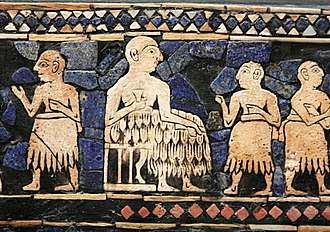
Some scholars contest the idea of a Proto-Euphratean language or one substrate language; they think the Sumerian language may originally have been that of the hunting and fishing peoples who lived in the marshland and the Eastern Arabia littoral region and were part of the Arabian bifacial culture.[29] Reliable historical records begin much later; there are none in Sumer of any kind that have been dated before Enmebaragesi (c. 26th century BC). Juris Zarins believes the Sumerians lived along the coast of Eastern Arabia, today's Persian Gulf region, before it was flooded at the end of the Ice Age.[30]
Sumerian civilization took form in the Uruk period (4th millennium BC), continuing into the Jemdet Nasr and Early Dynastic periods. During the 3rd millennium BC, a close cultural symbiosis developed between the Sumerians, who spoke a language isolate, and Akkadians, which gave rise to widespread bilingualism.[31] The influence of Sumerian on Akkadian (and vice versa) is evident in all areas, from lexical borrowing on a massive scale, to syntactic, morphological, and phonological convergence.[31] This has prompted scholars to refer to Sumerian and Akkadian in the 3rd millennium BC as a Sprachbund.[31]
The Sumerians progressively lost control to Semitic states from the northwest. Sumer was conquered by the Semitic-speaking kings of the Akkadian Empire around 2270 BC (short chronology), but Sumerian continued as a sacred language. Native Sumerian rule re-emerged for about a century in the Third Dynasty of Ur at approximately 2100–2000 BC, but the Akkadian language also remained in use for some time.[32]
The Sumerian city of Eridu, on the coast of the Persian Gulf, is considered to have been one of the oldest cities, where three separate cultures may have fused: that of peasant Ubaidian farmers, living in mud-brick huts and practicing irrigation; that of mobile nomadic Semitic pastoralists living in black tents and following herds of sheep and goats; and that of fisher folk, living in reed huts in the marshlands, who may have been the ancestors of the Sumerians.[32]
City-states in Mesopotamia
In the late 4th millennium BC, Sumer was divided into many independent city-states, which were divided by canals and boundary stones. Each was centered on a temple dedicated to the particular patron god or goddess of the city and ruled over by a priestly governor (ensi) or by a king (lugal) who was intimately tied to the city's religious rites.
The five "first" cities, said to have exercised pre-dynastic kingship "before the flood":
- Eridu (Tell Abu Shahrain)
- Bad-tibira (probably Tell al-Madain)
- Larsa (Tell as-Senkereh)
- Sippar (Tell Abu Habbah)
- Shuruppak (Tell Fara)
Other principal cities:
- (1location uncertain)
- (2an outlying city in northern Mesopotamia)
Minor cities (from south to north):
- Kuara (Tell al-Lahm)
- Zabala (Tell Ibzeikh)
- Kisurra (Tell Abu Hatab)
- Marad (Tell Wannat es-Sadum)
- Dilbat (Tell ed-Duleim)
- Borsippa (Birs Nimrud)
- Kutha (Tell Ibrahim)
- Der (al-Badra)
- Eshnunna (Tell Asmar)
- Nagar (Tell Brak) 2
(2an outlying city in northern Mesopotamia)
Apart from Mari, which lies full 330 kilometres (205 miles) north-west of Agade, but which is credited in the king list as having "exercised kingship" in the Early Dynastic II period, and Nagar, an outpost, these cities are all in the Euphrates-Tigris alluvial plain, south of Baghdad in what are now the Bābil, Diyala, Wāsit, Dhi Qar, Basra, Al-Muthannā and Al-Qādisiyyah governorates of Iraq.
History
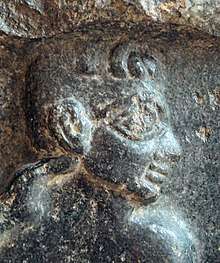
The Sumerian city-states rose to power during the prehistoric Ubaid and Uruk periods. Sumerian written history reaches back to the 27th century BC and before, but the historical record remains obscure until the Early Dynastic III period, c. the 23rd century BC, when a now deciphered syllabary writing system was developed, which has allowed archaeologists to read contemporary records and inscriptions. Classical Sumer ends with the rise of the Akkadian Empire in the 23rd century BC. Following the Gutian period, there was a brief Sumerian Renaissance in the 21st century BC, cut short in the 20th century BC by invasions by the Amorites. The Amorite "dynasty of Isin" persisted until c. 1700 BC, when Mesopotamia was united under Babylonian rule. The Sumerians were eventually absorbed into the Akkadian (Assyro-Babylonian) population.
- Ubaid period: 6500–4100 BC (Pottery Neolithic to Chalcolithic)
- Uruk period: 4100–2900 BC (Late Chalcolithic to Early Bronze Age I)
- Uruk XIV-V: 4100–3300 BC
- Uruk IV period: 3300–3100 BC
- Jemdet Nasr period (Uruk III): 3100–2900 BC
- Early Dynastic period (Early Bronze Age II–IV)
- Early Dynastic I period: 2900–2800 BC
- Early Dynastic II period: 2800–2600 BC (Gilgamesh)
- Early Dynastic IIIa period: 2600–2500 BC
- Early Dynastic IIIb period: c. 2500–2334 BC
- Akkadian Empire period: c. 2334–2218 BC (Sargon)
- Gutian period: c. 2218–2047 BC (Early Bronze Age IV)
- Ur III period: c. 2047–1940 BC
Ubaid period

The Ubaid period is marked by a distinctive style of fine quality painted pottery which spread throughout Mesopotamia and the Persian Gulf. During this time, the first settlement in southern Mesopotamia was established at Eridu (Cuneiform: nun.ki 𒉣 𒆠), c. 6500 BC, by farmers who brought with them the Hadji Muhammed culture, which first pioneered irrigation agriculture. It appears that this culture was derived from the Samarran culture from northern Mesopotamia. It is not known whether or not these were the actual Sumerians who are identified with the later Uruk culture. The rise of the city of Uruk may be reflected in the story of the passing of the gifts of civilization (me) to Inanna, goddess of Uruk and of love and war, by Enki, god of wisdom and chief god of Eridu, may reflect the transition from Eridu to Uruk.[37]:174
Uruk period
The archaeological transition from the Ubaid period to the Uruk period is marked by a gradual shift from painted pottery domestically produced on a slow wheel to a great variety of unpainted pottery mass-produced by specialists on fast wheels. The Uruk period is a continuation and an outgrowth of Ubaid with pottery being the main visible change.[38][39]
By the time of the Uruk period (c. 4100–2900 BC calibrated), the volume of trade goods transported along the canals and rivers of southern Mesopotamia facilitated the rise of many large, stratified, temple-centered cities (with populations of over 10,000 people) where centralized administrations employed specialized workers. It is fairly certain that it was during the Uruk period that Sumerian cities began to make use of slave labor captured from the hill country, and there is ample evidence for captured slaves as workers in the earliest texts. Artifacts, and even colonies of this Uruk civilization have been found over a wide area—from the Taurus Mountains in Turkey, to the Mediterranean Sea in the west, and as far east as central Iran.[40]
The Uruk period civilization, exported by Sumerian traders and colonists (like that found at Tell Brak), had an effect on all surrounding peoples, who gradually evolved their own comparable, competing economies and cultures. The cities of Sumer could not maintain remote, long-distance colonies by military force.[40]
Sumerian cities during the Uruk period were probably theocratic and were most likely headed by a priest-king (ensi), assisted by a council of elders, including both men and women.[41] It is quite possible that the later Sumerian pantheon was modeled upon this political structure. There was little evidence of organized warfare or professional soldiers during the Uruk period, and towns were generally unwalled. During this period Uruk became the most urbanized city in the world, surpassing for the first time 50,000 inhabitants.
The ancient Sumerian king list includes the early dynasties of several prominent cities from this period. The first set of names on the list is of kings said to have reigned before a major flood occurred. These early names may be fictional, and include some legendary and mythological figures, such as Alulim and Dumizid.[41]
The end of the Uruk period coincided with the Piora oscillation, a dry period from c. 3200–2900 BC that marked the end of a long wetter, warmer climate period from about 9,000 to 5,000 years ago, called the Holocene climatic optimum.[42]
Early Dynastic Period
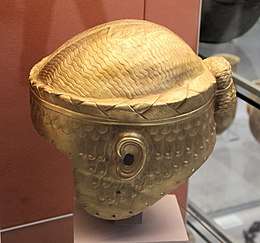
The dynastic period begins c. 2900 BC and was associated with a shift from the temple establishment headed by council of elders led by a priestly "En" (a male figure when it was a temple for a goddess, or a female figure when headed by a male god)[43] towards a more secular Lugal (Lu = man, Gal = great) and includes such legendary patriarchal figures as Enmerkar, Lugalbanda and Gilgamesh—who reigned shortly before the historic record opens c. 2700 BC, when the now deciphered syllabic writing started to develop from the early pictograms. The center of Sumerian culture remained in southern Mesopotamia, even though rulers soon began expanding into neighboring areas, and neighboring Semitic groups adopted much of Sumerian culture for their own.
The earliest dynastic king on the Sumerian king list whose name is known from any other legendary source is Etana, 13th king of the first dynasty of Kish. The earliest king authenticated through archaeological evidence is Enmebaragesi of Kish (c. 26th century BC), whose name is also mentioned in the Gilgamesh epic—leading to the suggestion that Gilgamesh himself might have been a historical king of Uruk. As the Epic of Gilgamesh shows, this period was associated with increased war. Cities became walled, and increased in size as undefended villages in southern Mesopotamia disappeared. (Both Enmerkar and Gilgamesh are credited with having built the walls of Uruk[44]).
1st Dynasty of Lagash
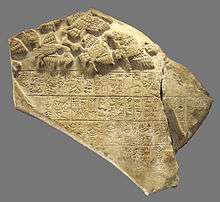
c. 2500–2270 BC
The dynasty of Lagash, though omitted from the king list, is well attested through several important monuments and many archaeological finds.
Although short-lived, one of the first empires known to history was that of Eannatum of Lagash, who annexed practically all of Sumer, including Kish, Uruk, Ur, and Larsa, and reduced to tribute the city-state of Umma, arch-rival of Lagash. In addition, his realm extended to parts of Elam and along the Persian Gulf. He seems to have used terror as a matter of policy.[45] Eannatum's Stele of the Vultures depicts vultures pecking at the severed heads and other body parts of his enemies. His empire collapsed shortly after his death.
Later, Lugal-Zage-Si, the priest-king of Umma, overthrew the primacy of the Lagash dynasty in the area, then conquered Uruk, making it his capital, and claimed an empire extending from the Persian Gulf to the Mediterranean. He was the last ethnically Sumerian king before Sargon of Akkad.[32]
Akkadian Empire
The Akkadian Empire dates to c. 2270–2083 BC (short chronology). The Eastern Semitic Akkadian language is first attested in proper names of the kings of Kish c. 2800 BC,[45] preserved in later king lists. There are texts written entirely in Old Akkadian dating from c. 2500 BC. Use of Old Akkadian was at its peak during the rule of Sargon the Great (c. 2270–2215 BC), but even then most administrative tablets continued to be written in Sumerian, the language used by the scribes. Gelb and Westenholz differentiate three stages of Old Akkadian: that of the pre-Sargonic era, that of the Akkadian empire, and that of the "Neo-Sumerian Renaissance" that followed it. Akkadian and Sumerian coexisted as vernacular languages for about one thousand years, but by around 1800 BC, Sumerian was becoming more of a literary language familiar mainly only to scholars and scribes. Thorkild Jacobsen has argued that there is little break in historical continuity between the pre- and post-Sargon periods, and that too much emphasis has been placed on the perception of a "Semitic vs. Sumerian" conflict.[46] However, it is certain that Akkadian was also briefly imposed on neighboring parts of Elam that were previously conquered, by Sargon.
Gutian period
c. 2083–2050 BC (short chronology)
2nd Dynasty of Lagash
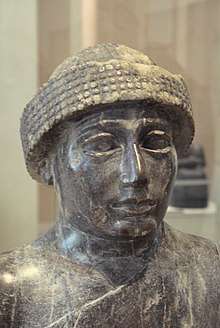
c. 2093–2046 BC (short chronology)
Following the downfall of the Akkadian Empire at the hands of Gutians, another native Sumerian ruler, Gudea of Lagash, rose to local prominence and continued the practices of the Sargonid kings' claims to divinity. The previous Lagash dynasty, Gudea and his descendants also promoted artistic development and left a large number of archaeological artifacts.
"Neo-Sumerian" Ur III period
c. 2047–1940 BC (short chronology)
Later, the 3rd dynasty of Ur under Ur-Nammu and Shulgi, whose power extended as far as southern Assyria, was the last great "Sumerian renaissance", but already the region was becoming more Semitic than Sumerian, with the resurgence of the Akkadian speaking Semites in Assyria and elsewhere, and the influx of waves of Semitic Martu (Amorites) who were to found several competing local powers in the south, including Isin, Larsa, Eshnunna and some time later Babylonia. The last of these eventually came to briefly dominate the south of Mesopotamia as the Babylonian Empire, just as the Old Assyrian Empire had already done so in the north from the late 21st century BC. The Sumerian language continued as a sacerdotal language taught in schools in Babylonia and Assyria, much as Latin was used in the Medieval period, for as long as cuneiform was utilized.
Fall and transmission
This period is generally taken to coincide with a major shift in population from southern Mesopotamia toward the north. Ecologically, the agricultural productivity of the Sumerian lands was being compromised as a result of rising salinity. Soil salinity in this region had been long recognized as a major problem. Poorly drained irrigated soils, in an arid climate with high levels of evaporation, led to the buildup of dissolved salts in the soil, eventually reducing agricultural yields severely. During the Akkadian and Ur III phases, there was a shift from the cultivation of wheat to the more salt-tolerant barley, but this was insufficient, and during the period from 2100 BC to 1700 BC, it is estimated that the population in this area declined by nearly three fifths.[47] This greatly upset the balance of power within the region, weakening the areas where Sumerian was spoken, and comparatively strengthening those where Akkadian was the major language. Henceforth, Sumerian would remain only a literary and liturgical language, similar to the position occupied by Latin in medieval Europe.
Following an Elamite invasion and sack of Ur during the rule of Ibbi-Sin (c. 1940 BC), Sumer came under Amorite rule (taken to introduce the Middle Bronze Age). The independent Amorite states of the 20th to 18th centuries are summarized as the "Dynasty of Isin" in the Sumerian king list, ending with the rise of Babylonia under Hammurabi c. 1700 BC.
Later rulers who dominated Assyria and Babylonia occasionally assumed the old Sargonic title "King of Sumer and Akkad", such as Tukulti-Ninurta I of Assyria after c. 1225 BC.
Population
Uruk, one of Sumer's largest cities, has been estimated to have had a population of 50,000–80,000 at its height;[48] given the other cities in Sumer, and the large agricultural population, a rough estimate for Sumer's population might be 0.8 million to 1.5 million. The world population at this time has been estimated at about 27 million.[49]
The Sumerians spoke a language isolate, but a number of linguists have claimed to be able to detect a substrate language of unknown classification beneath Sumerian because names of some of Sumer's major cities are not Sumerian, revealing influences of earlier inhabitants.[50] However, the archaeological record shows clear uninterrupted cultural continuity from the time of the early Ubaid period (5300–4700 BC C-14) settlements in southern Mesopotamia. The Sumerian people who settled here farmed the lands in this region that were made fertile by silt deposited by the Tigris and the Euphrates.
Some archaeologists have speculated that the original speakers of ancient Sumerian may have been farmers, who moved down from the north of Mesopotamia after perfecting irrigation agriculture there. The Ubaid period pottery of southern Mesopotamia has been connected via Choga Mami transitional ware to the pottery of the Samarra period culture (c. 5700–4900 BC C-14) in the north, who were the first to practice a primitive form of irrigation agriculture along the middle Tigris River and its tributaries. The connection is most clearly seen at Tell Awayli (Oueilli, Oueili) near Larsa, excavated by the French in the 1980s, where eight levels yielded pre-Ubaid pottery resembling Samarran ware. According to this theory, farming peoples spread down into southern Mesopotamia because they had developed a temple-centered social organization for mobilizing labor and technology for water control, enabling them to survive and prosper in a difficult environment.
Others have suggested a continuity of Sumerians, from the indigenous hunter-fisherfolk traditions, associated with the bifacial assemblages found on the Arabian littoral. Juris Zarins believes the Sumerians may have been the people living in the Persian Gulf region before it flooded at the end of the last Ice Age.[51]
Culture
Social and family life
In the early Sumerian period, the primitive pictograms suggest[52] that
- "Pottery was very plentiful, and the forms of the vases, bowls and dishes were manifold; there were special jars for honey, butter, oil and wine, which was probably made from dates. Some of the vases had pointed feet, and stood on stands with crossed legs; others were flat-bottomed, and were set on square or rectangular frames of wood. The oil-jars, and probably others also, were sealed with clay, precisely as in early Egypt. Vases and dishes of stone were made in imitation of those of clay."
- "A feathered head-dress was worn. Beds, stools and chairs were used, with carved legs resembling those of an ox. There were fire-places and fire-altars."
- "Knives, drills, wedges and an instrument that looks like a saw were all known. While spears, bows, arrows, and daggers (but not swords) were employed in war."
- "Tablets were used for writing purposes. Daggers with metal blades and wooden handles were worn, and copper was hammered into plates, while necklaces or collars were made of gold."
- "Time was reckoned in lunar months."
There is considerable evidence concerning Sumerian music. Lyres and flutes were played, among the best-known examples being the Lyres of Ur.[53]
Inscriptions describing the reforms of king Urukagina of Lagash (c. 2300 BC) say that he abolished the former custom of polyandry in his country, prescribing that a woman who took multiple husbands be stoned with rocks upon which her crime had been written.[54]
Louvre Museum AO 295.
Sumerian culture was male-dominated and stratified. The Code of Ur-Nammu, the oldest such codification yet discovered, dating to the Ur III, reveals a glimpse at societal structure in late Sumerian law. Beneath the lu-gal ("great man" or king), all members of society belonged to one of two basic strata: The "lu" or free person, and the slave (male, arad; female geme). The son of a lu was called a dumu-nita until he married. A woman (munus) went from being a daughter (dumu-mi), to a wife (dam), then if she outlived her husband, a widow (numasu) and she could then remarry another man who was from the same tribe.
Marriages were usually arranged by the parents of the bride and groom;[55]:78 engagements were usually completed through the approval of contracts recorded on clay tablets.[55]:78 These marriages became legal as soon as the groom delivered a bridal gift to his bride's father.[55]:78 One Sumerian proverb describes the ideal, happy marriage through the mouth of a husband who boasts that his wife has borne him eight sons and is still eager to have sex.[56]
The Sumerians generally seem to have discouraged premarital sex,[57] but it was probably very commonly done in secret.[55]:78 The Sumerians, as well as the later Akkadians, had no concept of virginity.[58]:91–93 When describing a woman's sexual inexperience, instead of calling her a "virgin", Sumerian texts describe which sex acts she had not yet performed.[58]:92 The Sumerians had no knowledge of the existence of the hymen[58]:92 and whether or not a prospective bride had engaged in sexual intercourse was entirely determined by her own word.[58]:91–92
From the earliest records, the Sumerians had very relaxed attitudes toward sex[59] and their sexual mores were determined not by whether a sexual act was deemed immoral, but rather by whether or not it made a person ritually unclean.[59] The Sumerians widely believed that masturbation enhanced sexual potency, both for men and for women,[59] and they frequently engaged in it, both alone and with their partners.[59] The Sumerians did not regard anal sex as taboo either.[59] Entu priestesses were forbidden from producing offspring[60][56] and frequently engaged in anal sex as a method of birth control.[60][59][56]
Prostitution existed but it is not clear if sacred prostitution did.[61]:151
Language and writing


The most important archaeological discoveries in Sumer are a large number of clay tablets written in cuneiform script. Sumerian writing is considered to be a great milestone in the development of humanity's ability to not only create historical records but also in creating pieces of literature, both in the form of poetic epics and stories as well as prayers and laws. Although pictures—that is, hieroglyphs—were used first, cuneiform and then ideograms (where symbols were made to represent ideas) soon followed. Triangular or wedge-shaped reeds were used to write on moist clay. A large body of hundreds of thousands of texts in the Sumerian language have survived, such as personal and business letters, receipts, lexical lists, laws, hymns, prayers, stories, and daily records. Full libraries of clay tablets have been found. Monumental inscriptions and texts on different objects, like statues or bricks, are also very common. Many texts survive in multiple copies because they were repeatedly transcribed by scribes in training. Sumerian continued to be the language of religion and law in Mesopotamia long after Semitic speakers had become dominant.
A prime example of cuneiform writing would be a lengthy poem that was discovered in the ruins of Uruk. The Epic of Gilgamesh was written in the standard Sumerian cuneiform. It tells of a king from the early Dynastic II period named Gilgamesh or "Bilgamesh" in Sumerian. The story is based around the fictional adventures of Gilgamesh and his companion, Enkidu. It was laid out on several clay tablets and is claimed to be the earliest example of a fictional, written piece of literature discovered so far.
The Sumerian language is generally regarded as a language isolate in linguistics because it belongs to no known language family; Akkadian, by contrast, belongs to the Semitic branch of the Afroasiatic languages. There have been many failed attempts to connect Sumerian to other language families. It is an agglutinative language; in other words, morphemes ("units of meaning") are added together to create words, unlike analytic languages where morphemes are purely added together to create sentences. Some authors have proposed that there may be evidence of a substratum or adstratum language for geographic features and various crafts and agricultural activities, called variously Proto-Euphratean or Proto Tigrean, but this is disputed by others.
Understanding Sumerian texts today can be problematic. Most difficult are the earliest texts, which in many cases do not give the full grammatical structure of the language and seem to have been used as an "aide-mémoire" for knowledgeable scribes.[64]
During the 3rd millennium BC a cultural symbiosis developed between the Sumerians and the Akkadians, which included widespread bilingualism.[31] The influences between Sumerian on Akkadian are evident in all areas including lexical borrowing on a massive scale—and syntactic, morphological, and phonological convergence.[31] This mutual influence has prompted scholars to refer to Sumerian and Akkadian of the 3rd millennium BC as a Sprachbund.[31]
Akkadian gradually replaced Sumerian as a spoken language somewhere around the turn of the 3rd and the 2nd millennium BC,[65] but Sumerian continued to be used as a sacred, ceremonial, literary, and scientific language in Babylonia and Assyria until the 1st century AD.[66]
 Early writing tablet for recording the allocation of beer; 3100–3000 BC; height: 9.4 cm; width: 6.87 cm; from Iraq; British Museum (London)
Early writing tablet for recording the allocation of beer; 3100–3000 BC; height: 9.4 cm; width: 6.87 cm; from Iraq; British Museum (London) Cuneiform tablet about administrative account with entries concerning malt and barley groats; 3100-2900 BC; clay; 6.8 x 4.5 x 1.6 cm; Metropolitan Museum of Art (New York City)
Cuneiform tablet about administrative account with entries concerning malt and barley groats; 3100-2900 BC; clay; 6.8 x 4.5 x 1.6 cm; Metropolitan Museum of Art (New York City)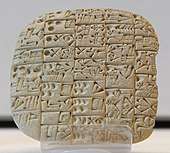 Bill of sale of a field and house, from Shuruppak; circa 2600 BC; height: 8.5 cm, width: 8.5 cm, depth: 2 cm; Louvre
Bill of sale of a field and house, from Shuruppak; circa 2600 BC; height: 8.5 cm, width: 8.5 cm, depth: 2 cm; Louvre Stele of the Vultures; circa 2450 BC; limestone; found in 1881 by Édouard de Sarzec in Girsu (now Tell Telloh, Iraq); Louvre
Stele of the Vultures; circa 2450 BC; limestone; found in 1881 by Édouard de Sarzec in Girsu (now Tell Telloh, Iraq); Louvre
Religion
The Sumerians credited their divinities for all matters pertaining to them and exhibited humility in the face of cosmic forces, such as death and divine wrath.[55]:3–4
Sumerian religion seems to have been founded upon two separate cosmogenic myths. The first saw creation as the result of a series of hieroi gamoi or sacred marriages, involving the reconciliation of opposites, postulated as a coming together of male and female divine beings; the gods. This continued to influence the whole Mesopotamian mythos. Thus, in the later Akkadian Enuma Elish, the creation was seen as the union of fresh and salt water; as male Abzu, and female Tiamat. The products of that union, Lahm and Lahmu, "the muddy ones", were titles given to the gate keepers of the E-Abzu temple of Enki, in Eridu, the first Sumerian city. Describing the way that muddy islands emerge from the confluence of fresh and salty water at the mouth of the Euphrates, where the river deposited its load of silt, a second hieros gamos supposedly created Anshar and Kishar, the "sky-pivot" or axle, and the "earth pivot", parents in turn of Anu (the sky) and Ki (the earth). Another important Sumerian hieros gamos was that between Ki, here known as Ninhursag or "Lady of the Mountains", and Enki of Eridu, the god of fresh water which brought forth greenery and pasture.
At an early stage, following the dawn of recorded history, Nippur, in central Mesopotamia, replaced Eridu in the south as the primary temple city, whose priests exercised political hegemony on the other city-states. Nippur retained this status throughout the Sumerian period.
Deities
_-_EnKi_(Sumerian).jpg)
Sumerians believed in an anthropomorphic polytheism, or the belief in many gods in human form. There was no common set of gods; each city-state had its own patrons, temples, and priest-kings. Nonetheless, these were not exclusive; the gods of one city were often acknowledged elsewhere. Sumerian speakers were among the earliest people to record their beliefs in writing, and were a major inspiration in later Mesopotamian mythology, religion, and astrology.
The Sumerians worshiped:
- An as the full-time god equivalent to heaven; indeed, the word an in Sumerian means sky and his consort Ki, means earth.
- Enki in the south at the temple in Eridu. Enki was the god of beneficence and of wisdom, ruler of the freshwater depths beneath the earth, a healer and friend to humanity who in Sumerian myth was thought to have given humans the arts and sciences, the industries and manners of civilization; the first law book was considered his creation,
- Enlil was the god of storm, wind, and rain.[67]:108 He was the chief god of the Sumerian pantheon[67]:108[68]:115–121 and the patron god of Nippur.[69]:231–234 His consort was Ninlil, the goddess of the south wind.[70]:106
- Inanna was the goddess of love, beauty, sexuality, prostitution, and war;[37][61]:109 the deification of Venus, the morning (eastern) and evening (western) star, at the temple (shared with An) at Uruk. Deified kings may have re-enacted the marriage of Inanna and Dumuzid with priestesses.[61]:151, 157–158
- The sun-god Utu at Larsa in the south and Sippar in the north,
- The moon god Sin at Ur.

These deities formed a core pantheon; there were additionally hundreds of minor ones. Sumerian gods could thus have associations with different cities, and their religious importance often waxed and waned with those cities' political power. The gods were said to have created human beings from clay for the purpose of serving them. The temples organized the mass labour projects needed for irrigation agriculture. Citizens had a labor duty to the temple, though they could avoid it by a payment of silver.
Cosmology
Sumerians believed that the universe consisted of a flat disk enclosed by a dome. The Sumerian afterlife involved a descent into a gloomy netherworld to spend eternity in a wretched existence as a Gidim (ghost).[71]
The universe was divided into four quarters:
- To the north were the hill-dwelling Subartu, who were periodically raided for slaves, timber, and other raw materials.[72]
- To the west were the tent-dwelling Martu, ancient Semitic-speaking peoples living as pastoral nomads tending herds of sheep and goats.
- To the south was the land of Dilmun, a trading state associated with the land of the dead and the place of creation.[73]
- To the east were the Elamites, a rival people with whom the Sumerians were frequently at war.
Their known world extended from The Upper Sea or Mediterranean coastline, to The Lower Sea, the Persian Gulf and the land of Meluhha (probably the Indus Valley) and Magan (Oman), famed for its copper ores.
Temple and temple organisation
Ziggurats (Sumerian temples) each had an individual name and consisted of a forecourt, with a central pond for purification.[74] The temple itself had a central nave with aisles along either side. Flanking the aisles would be rooms for the priests. At one end would stand the podium and a mudbrick table for animal and vegetable sacrifices. Granaries and storehouses were usually located near the temples. After a time the Sumerians began to place the temples on top of multi-layered square constructions built as a series of rising terraces, giving rise to the Ziggurat style.[75]
Funerary practices
It was believed that when people died, they would be confined to a gloomy world of Ereshkigal, whose realm was guarded by gateways with various monsters designed to prevent people entering or leaving. The dead were buried outside the city walls in graveyards where a small mound covered the corpse, along with offerings to monsters and a small amount of food. Those who could afford it sought burial at Dilmun.[73] Human sacrifice was found in the death pits at the Ur royal cemetery where Queen Puabi was accompanied in death by her servants.
Agriculture and hunting
The Sumerians adopted an agricultural lifestyle perhaps as early as c. 5000 BC – 4500 BC. The region demonstrated a number of core agricultural techniques, including organized irrigation, large-scale intensive cultivation of land, mono-cropping involving the use of plough agriculture, and the use of an agricultural specialized labour force under bureaucratic control. The necessity to manage temple accounts with this organization led to the development of writing (c. 3500 BC).

In the early Sumerian Uruk period, the primitive pictograms suggest that sheep, goats, cattle, and pigs were domesticated. They used oxen as their primary beasts of burden and donkeys or equids as their primary transport animal and "woollen clothing as well as rugs were made from the wool or hair of the animals. ... By the side of the house was an enclosed garden planted with trees and other plants; wheat and probably other cereals were sown in the fields, and the shaduf was already employed for the purpose of irrigation. Plants were also grown in pots or vases."[52]
The Sumerians were one of the first known beer drinking societies. Cereals were plentiful and were the key ingredient in their early brew. They brewed multiple kinds of beer consisting of wheat, barley, and mixed grain beers. Beer brewing was very important to the Sumerians. It was referenced in the Epic of Gilgamesh when Enkidu was introduced to the food and beer of Gilgamesh's people: "Drink the beer, as is the custom of the land... He drank the beer-seven jugs! and became expansive and sang with joy!"[76]
The Sumerians practiced similar irrigation techniques as those used in Egypt.[77] American anthropologist Robert McCormick Adams says that irrigation development was associated with urbanization,[78] and that 89% of the population lived in the cities.
They grew barley, chickpeas, lentils, wheat, dates, onions, garlic, lettuce, leeks and mustard. Sumerians caught many fish and hunted fowl and gazelle.[79]
Sumerian agriculture depended heavily on irrigation. The irrigation was accomplished by the use of shaduf, canals, channels, dykes, weirs, and reservoirs. The frequent violent floods of the Tigris, and less so, of the Euphrates, meant that canals required frequent repair and continual removal of silt, and survey markers and boundary stones needed to be continually replaced. The government required individuals to work on the canals in a corvee, although the rich were able to exempt themselves.
As is known from the "Sumerian Farmer's Almanac", after the flood season and after the Spring equinox and the Akitu or New Year Festival, using the canals, farmers would flood their fields and then drain the water. Next they made oxen stomp the ground and kill weeds. They then dragged the fields with pickaxes. After drying, they plowed, harrowed, and raked the ground three times, and pulverized it with a mattock, before planting seed. Unfortunately, the high evaporation rate resulted in a gradual increase in the salinity of the fields. By the Ur III period, farmers had switched from wheat to the more salt-tolerant barley as their principal crop.
Sumerians harvested during the spring in three-person teams consisting of a reaper, a binder, and a sheaf handler.[80] The farmers would use threshing wagons, driven by oxen, to separate the cereal heads from the stalks and then use threshing sleds to disengage the grain. They then winnowed the grain/chaff mixture.
Art

The Sumerians were great creators, nothing proving this more than their art. Sumerian artifacts show great detail and ornamentation, with fine semi-precious stones imported from other lands, such as lapis lazuli, marble, and diorite, and precious metals like hammered gold, incorporated into the design. Since stone was rare it was reserved for sculpture. The most widespread material in Sumer was clay, as a result many Sumerina objects are made of clay. Metals such as gold, silver, copper, and bronze, along with shells and gemstones, were used for the finest sculpture and inlays. Small stones of all kinds, including more precious stones such as lapis lazuli, alabaster, and serpentine, were used for cylinder seals.
Some of the most famous masterpieces are the Lyres of Ur, which are considered to be the world's oldest surviving stringed instruments. They have been discovered by Leonard Woolley when the Royal Cemetery of Ur has been excavated between from 1922 and 1934.
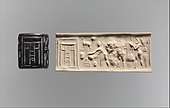 Cylinder seal and impression in which appears a ritual scene before a temple façade; 3500-3100 BC; bituminous limestone; height: 4.5 cm; Metropolitan Museum of Art (New York City)
Cylinder seal and impression in which appears a ritual scene before a temple façade; 3500-3100 BC; bituminous limestone; height: 4.5 cm; Metropolitan Museum of Art (New York City)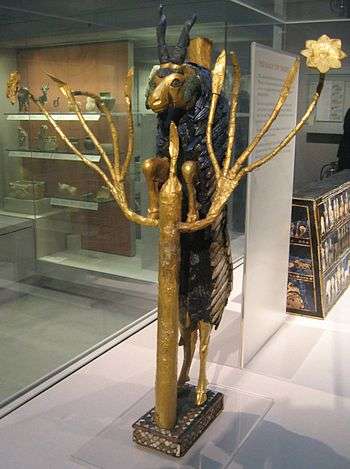 Ram in a Thicket; 2600-2400 BC; gold, copper, shell, lapis lazuli and limestone; height: 45.7 cm; from the Royal Cemetery at Ur (Dhi Qar Governorate, Iraq); British Museum (London)
Ram in a Thicket; 2600-2400 BC; gold, copper, shell, lapis lazuli and limestone; height: 45.7 cm; from the Royal Cemetery at Ur (Dhi Qar Governorate, Iraq); British Museum (London)_(2).jpg) Standard of Ur; 2600-2400 BC; shell, red limestone and lapis lazuli on wood; length: 49.5 cm; from the Royal Cemetery at Ur; British Museum
Standard of Ur; 2600-2400 BC; shell, red limestone and lapis lazuli on wood; length: 49.5 cm; from the Royal Cemetery at Ur; British Museum Bull's head ornament from a lyre; 2600-2350 BC; bronze inlaid with shell and lapis lazuli; height: 13.3 cm, width: 10.5 cm; Metropolitan Museum of Art
Bull's head ornament from a lyre; 2600-2350 BC; bronze inlaid with shell and lapis lazuli; height: 13.3 cm, width: 10.5 cm; Metropolitan Museum of Art
Architecture

The Tigris-Euphrates plain lacked minerals and trees. Sumerian structures were made of plano-convex mudbrick, not fixed with mortar or cement. Mud-brick buildings eventually deteriorate, so they were periodically destroyed, leveled, and rebuilt on the same spot. This constant rebuilding gradually raised the level of cities, which thus came to be elevated above the surrounding plain. The resultant hills, known as tells, are found throughout the ancient Near East.
According to Archibald Sayce, the primitive pictograms of the early Sumerian (i.e. Uruk) era suggest that "Stone was scarce, but was already cut into blocks and seals. Brick was the ordinary building material, and with it cities, forts, temples and houses were constructed. The city was provided with towers and stood on an artificial platform; the house also had a tower-like appearance. It was provided with a door which turned on a hinge, and could be opened with a sort of key; the city gate was on a larger scale, and seems to have been double. The foundation stones—or rather bricks—of a house were consecrated by certain objects that were deposited under them."[52]
The most impressive and famous of Sumerian buildings are the ziggurats, large layered platforms that supported temples. Sumerian cylinder seals also depict houses built from reeds not unlike those built by the Marsh Arabs of Southern Iraq until as recently as 400 CE. The Sumerians also developed the arch, which enabled them to develop a strong type of dome. They built this by constructing and linking several arches. Sumerian temples and palaces made use of more advanced materials and techniques, such as buttresses, recesses, half columns, and clay nails.
Mathematics
The Sumerians developed a complex system of metrology c. 4000 BC. This advanced metrology resulted in the creation of arithmetic, geometry, and algebra. From c. 2600 BC onwards, the Sumerians wrote multiplication tables on clay tablets and dealt with geometrical exercises and division problems. The earliest traces of the Babylonian numerals also date back to this period.[81] The period c. 2700–2300 BC saw the first appearance of the abacus, and a table of successive columns which delimited the successive orders of magnitude of their sexagesimal number system.[82] The Sumerians were the first to use a place value numeral system. There is also anecdotal evidence the Sumerians may have used a type of slide rule in astronomical calculations. They were the first to find the area of a triangle and the volume of a cube.[83]
Economy and trade
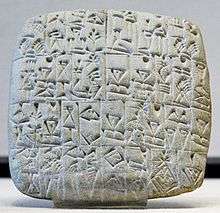
Discoveries of obsidian from far-away locations in Anatolia and lapis lazuli from Badakhshan in northeastern Afghanistan, beads from Dilmun (modern Bahrain), and several seals inscribed with the Indus Valley script suggest a remarkably wide-ranging network of ancient trade centered on the Persian Gulf. For example, Imports to Ur came from many parts of the world. In particular, the metals of all types had to be imported.
The Epic of Gilgamesh refers to trade with far lands for goods, such as wood, that were scarce in Mesopotamia. In particular, cedar from Lebanon was prized. The finding of resin in the tomb of Queen Puabi at Ur, indicates it was traded from as far away as Mozambique.
The Sumerians used slaves, although they were not a major part of the economy. Slave women worked as weavers, pressers, millers, and porters.
Sumerian potters decorated pots with cedar oil paints. The potters used a bow drill to produce the fire needed for baking the pottery. Sumerian masons and jewelers knew and made use of alabaster (calcite), ivory, iron, gold, silver, carnelian, and lapis lazuli.[84]
Trade with the Indus valley
.jpg)
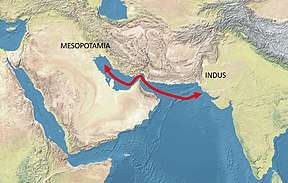
Evidence for imports from the Indus to Ur can be found from around 2350 BCE.[87] Various objects made with shell species that are characteristic of the Indus coast, particularly Trubinella Pyrum and Fasciolaria Trapezium, have been found in the archaeological sites of Mesopotamia dating from around 2500-2000 BCE.[88] Carnelian beads from the Indus were found in the Sumerian tombs of Ur, the Royal Cemetery at Ur, dating to 2600-2450.[89] In particular, carnelian beads with an etched design in white were probably imported from the Indus Valley, and made according to a technique of acid-etching developed by the Harappans.[90][85][91] Lapis Lazuli was imported in great quantity by Egypt, and already used in many tombs of the Naqada II period (circa 3200 BCE). Lapis Lazuli probably originated in northern Afghanistan, as no other sources are known, and had to be transported across the Iranian plateau to Mesopotamia, and then Egypt.[92][93]
Several Indus seals with Harappan script have also been found in Mesopotamia, particularly in Ur, Babylon and Kish.[94][95][96][97][98][99]
Gudea, the ruler of the Neo-Summerian Empire at Lagash, is recorded as having imported "translucent carnelian" from Meluhha, generally thought to be the Indus Valley area.[89] Various inscriptions also mention the presence of Meluhha traders and interpreters in Mesopotamia.[89] About twenty seals have been found from the Akkadian and Ur III sites, that have connections with Harappa and often use Harappan symbols or writing.[89]
The Indus Valley Civilization only flourished in its most developed form between 2400 and 1800 BC, but at the time of these exchanges, it was a much larger entity than the Mesopotamian civilization, covering an area of 1.2 million square meters with thousands of settlements, compared to an area of only about 65.000 square meters for the occupied area of Mesopotamia, while the largest cities were comparable in size at about 30-40.000 inhabitants.[100]
Money and credit
Large institutions kept their accounts in barley and silver, often with a fixed rate between them. The obligations, loans and prices in general were usually denominated in one of them. Many transactions involved debt, for example goods consigned to merchants by temple and beer advanced by "ale women".[101]
Commercial credit and agricultural consumer loans were the main types of loans. The trade credit was usually extended by temples in order to finance trade expeditions and was nominated in silver. The interest rate was set at 1/60 a month (one shekel per mina) some time before 2000 BC and it remained at that level for about two thousand years.[101] Rural loans commonly arose as a result of unpaid obligations due to an institution (such as a temple), in this case the arrears were considered to be lent to the debtor.[102] They were denominated in barley or other crops and the interest rate was typically much higher than for commercial loans and could amount to 1/3 to 1/2 of the loan principal.[101]
Periodically, rulers signed "clean slate" decrees that cancelled all the rural (but not commercial) debt and allowed bondservants to return to their homes. Customarily, rulers did it at the beginning of the first full year of their reign, but they could also be proclaimed at times of military conflict or crop failure. The first known ones were made by Enmetena and Urukagina of Lagash in 2400–2350 BC. According to Hudson, the purpose of these decrees was to prevent debts mounting to a degree that they threatened the fighting force, which could happen if peasants lost the subsistence land or became bondservants due to the inability to repay the debt.[101]
Military

.jpg)

The almost constant wars among the Sumerian city-states for 2000 years helped to develop the military technology and techniques of Sumer to a high level.[103] The first war recorded in any detail was between Lagash and Umma in c. 2525 BC on a stele called the Stele of the Vultures. It shows the king of Lagash leading a Sumerian army consisting mostly of infantry. The infantry carried spears, wore copper helmets, and carried rectangular shields. The spearmen are shown arranged in what resembles the phalanx formation, which requires training and discipline; this implies that the Sumerians may have made use of professional soldiers.[104]
The Sumerian military used carts harnessed to onagers. These early chariots functioned less effectively in combat than did later designs, and some have suggested that these chariots served primarily as transports, though the crew carried battle-axes and lances. The Sumerian chariot comprised a four or two-wheeled device manned by a crew of two and harnessed to four onagers. The cart was composed of a woven basket and the wheels had a solid three-piece design.
Sumerian cities were surrounded by defensive walls. The Sumerians engaged in siege warfare between their cities, but the mudbrick walls were able to deter some foes.
Technology
Examples of Sumerian technology include: the wheel, cuneiform script, arithmetic and geometry, irrigation systems, Sumerian boats, lunisolar calendar, bronze, leather, saws, chisels, hammers, braces, bits, nails, pins, rings, hoes, axes, knives, lancepoints, arrowheads, swords, glue, daggers, waterskins, bags, harnesses, armor, quivers, war chariots, scabbards, boots, sandals, harpoons and beer. The Sumerians had three main types of boats:
- clinker-built sailboats stitched together with hair, featuring bitumen waterproofing
- skin boats constructed from animal skins and reeds
- wooden-oared ships, sometimes pulled upstream by people and animals walking along the nearby banks
Legacy
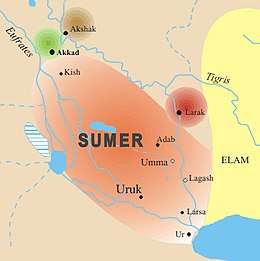
Evidence of wheeled vehicles appeared in the mid 4th millennium BC, near-simultaneously in Mesopotamia, the Northern Caucasus (Maykop culture) and Central Europe. The wheel initially took the form of the potter's wheel. The new concept led to wheeled vehicles and mill wheels. The Sumerians' cuneiform script is the oldest (or second oldest after the Egyptian hieroglyphs) which has been deciphered (the status of even older inscriptions such as the Jiahu symbols and Tartaria tablets is controversial). The Sumerians were among the first astronomers, mapping the stars into sets of constellations, many of which survived in the zodiac and were also recognized by the ancient Greeks.[105] They were also aware of the five planets that are easily visible to the naked eye.[106]
They invented and developed arithmetic by using several different number systems including a mixed radix system with an alternating base 10 and base 6. This sexagesimal system became the standard number system in Sumer and Babylonia. They may have invented military formations and introduced the basic divisions between infantry, cavalry, and archers. They developed the first known codified legal and administrative systems, complete with courts, jails, and government records. The first true city-states arose in Sumer, roughly contemporaneously with similar entities in what are now Syria and Lebanon. Several centuries after the invention of cuneiform, the use of writing expanded beyond debt/payment certificates and inventory lists to be applied for the first time, about 2600 BC, to messages and mail delivery, history, legend, mathematics, astronomical records, and other pursuits. Conjointly with the spread of writing, the first formal schools were established, usually under the auspices of a city-state's primary temple.
Finally, the Sumerians ushered in domestication with intensive agriculture and irrigation. Emmer wheat, barley, sheep (starting as mouflon), and cattle (starting as aurochs) were foremost among the species cultivated and raised for the first time on a grand scale.
Hungarian-Sumerian hypothesis
A hypothesis exists in Hungarian and international historiography that relates the Sumerians to the Hungarians. According to it, the Sumerian and Hungarian languages would be related and the ancestors of both peoples would have contacted in the past and share a common origin. This leaves a huge temporal gap and suggests a very extense origin for the Uralic peoples (as their Urheimat is generally believed to be at the west of the Ural Mountains). Most of its supporters deny a direct linguistic relationship between Hungarian and the other Finno-Ugric languages.[107]
The hypothesis had more popularity among sumerologists in the 19th and early 20th centuries. Nowadays, it is mostly dismissed, although it is acknowleged Sumerian is an agglutinative language, just like the Hungarian, Turkish and Finnish languages[108] and regarding linguistic structure resembles no little with these and some Caucasian languages, however in vocabulary, grammar, and syntax Sumerian still stands alone and seems to be unrelated to any other language, living or dead.[109] The hypothesis is considered as needing further study to deny or prove certain affinities and similarities between the Sumerians and the Uralic peoples (including Hungarians).[107]
See also
- History of Iraq
- History of writing numbers
- Ancient Mesopotamian units of measurement
- Ancient Mesopotamian religion
- Indus-Mesopotamia relations
Notes
- The name is from Akkadian Šumeru; Sumerian kig̃ir, written 𒆠𒂗𒄀 ki-en-gi and 𒆠𒂗𒂠 ki-en-ĝir15,approximately "land of the civilized kings" or "native land". ĝir15 means "native, local", in(ĝir NATIVE (7x: Old Babylonian) from The Pennsylvania Sumerian Dictionary). Literally, "land of the native (local, noble) lords". Stiebing (1994) has "Land of the Lords of Brightness" (William Stiebing, Ancient Near Eastern History and Culture). Postgate (1994) takes en as substituting eme "language", translating "land of the Sumerian heart" (John Nicholas Postgate (1994). Early Mesopotamia: Society and Economy at the Dawn of History. Routledge (UK).. Postgate believes it not that eme, 'tongue', became en, 'lord', through consonantal assimilation.)
References
- Cuneiform ancient.eu
- Foxvog, Daniel A. (2016). Elementary Sumerian Glossary (PDF). University of California at Berkeley. p. 52.
- "The Pennsylvania Sumerian Dictionary: saĝgiga[humankind]". psd.museum.upenn.edu.
- Diakonoff, I. M.; D'I︠A︡konov, Igor' Mik︠h︡aílovich (1991). Early Antiquity. University of Chicago Press. p. 72. ISBN 978-0-226-14465-8.
- Feuerstein, Georg; Kak, Subhash; Frawley, David (2005). The Search of the Cradle of Civilization: New Light on Ancient India. Motilal Banarsidass Publishe. p. 117. ISBN 978-81-208-2037-1.
- "The area in question (the extreme south of Mesopotamia) may now be called Sumer, and its inhabitants Sumerians, although these names are only English approximations of the Akkadian designations; the Sumerians themselves called their land Kengir, their language Emegir, and themselves Sag-giga, "black-headed ones." in W. Hallo; W. Simpson (1971). The Ancient Near East. New York: Harcourt, Brace, Jovanovich. p. 29.
- Black, Jeremy A.; George, A. R.; Postgate, J. N.; Breckwoldt, Tina (2000). A Concise Dictionary of Akkadian. Otto Harrassowitz Verlag. p. 384. ISBN 978-3-447-04264-2.
- Miller, Douglas B.; Shipp, R. Mark (1996). An Akkadian Handbook: Paradigms, Helps, Glossary, Logograms, and Sign List. Eisenbrauns. p. 68. ISBN 978-0-931464-86-7.
- Toorn, Karel van der; Becking, Bob; Horst, Pieter Willem van der (1999). Dictionary of Deities and Demons in the Bible. Wm. B. Eerdmans Publishing. p. 32. ISBN 978-0-8028-2491-2.
- Edzard, Dietz Otto (2003). Sumerian Grammar. BRILL. p. 1. ISBN 978-90-474-0340-1.
- "The origin of the Sumerians is unknown; they described themselves as the 'black-headed people'"Haywood, John (2005). The Penguin Historical Atlas of Ancient Civilizations. Penguin. p. 28. ISBN 978-0-14-101448-7.
- Diakonoff, I. M. (2013). Early Antiquity. University of Chicago Press. p. 72. ISBN 978-0-226-14467-2.
- Finer, Samuel Edward; Finer, S. E. (1997). The History of Government from the Earliest Times: Ancient monarchies and empires. Oxford University Press. p. 99. ISBN 978-0-19-820664-4.
- "I am the king of the four quarters, I am a shepherd, the pastor of the "black-headed people"" in Liverani, Mario (2013). The Ancient Near East: History, Society and Economy. Routledge. p. 167. ISBN 978-1-134-75084-9.
- K. van der Toorn, P.W. van der Horst (January 1990). "Nimrod before and after the Bible". The Harvard Theological Review. 83 (1): 1–29. doi:10.1017/S0017816000005502.
- Kramer, Samuel Noah (1988). In the World of Sumer: An Autobiography. Wayne State University Press. p. 44. ISBN 9780814321218.
- "Ancient Mesopotamia. Teaching materials". Oriental Institute in collaboration with Chicago Web Docent and eCUIP, The Digital Library. Retrieved 5 March 2015.
- "The Ubaid Period (5500–4000 B.C.)" In Heilbrunn Timeline of Art History. Department of Ancient Near Eastern Art. The Metropolitan Museum of Art, New York (October 2003)
- ""Ubaid Culture", The British Museum".
- ""Beyond the Ubaid", (Carter, Rober A. and Graham, Philip, eds.), University of Durham, April 2006" (PDF).
- Arnaiz-Villena, Antonio; Martínez-Laso, Jorge; Gómez-Casado, Eduardo (2000-01-31). Prehistoric Iberia: Genetics, Anthropology, and Linguistics : [proceedings of an International Conference on Prehistoric Iberia : Genetics, Anthropology, and Linguistics, Held November 16-17, 1998, in Madrid, Spain]. Springer Science & Business Media. p. 22. ISBN 9780306463648.
- "Craniometric analyses have suggested an affinity between the Natufians and populations of north or sub-Saharan Africa, a result that finds some support from Y chromosome analysis which shows that the Natufians and successor Levantine Neolithic populations carried haplogroup E, of likely ultimate African origin, which has not been detected in other ancient males from West Eurasia. However, no affinity of Natufians to sub-Saharan Africans is evident in our genome-wide analysis, as present-day sub-Saharan Africans do not share more alleles with Natufians than with other ancient Eurasians" in Reich, David; Pinhasi, Ron; Patterson, Nick; Hovhannisyan, Nelli A.; Yengo, Loic; Wilson, James F.; Torroni, Antonio; Tönjes, Anke; Stumvoll, Michael (August 2016). "Genomic insights into the origin of farming in the ancient Near East". Nature. 536 (7617): 419–424. Bibcode:2016Natur.536..419L. doi:10.1038/nature19310. ISSN 1476-4687. PMC 5003663.
- Płoszaj, Tomasz; Chaubey, Gyaneshwer; Jędrychowska-Dańska, Krystyna; Tomczyk, Jacek; Witas, Henryk W. (11 September 2013). "mtDNA from the Early Bronze Age to the Roman Period Suggests a Genetic Link between the Indian Subcontinent and Mesopotamian Cradle of Civilization". PLOS ONE. 8 (9): 1–20. doi:10.1371/journal.pone.0073682. ISSN 1932-6203. PMC 3770703.
- "Sumer (ancient region, Iraq)". Britannica Online Encyclopedia. Britannica.com. Retrieved 2012-03-29.
- Kleniewski, Nancy; Thomas, Alexander R (2010-03-26). Cities, Change, and Conflict: A Political Economy of Urban Life. ISBN 978-0-495-81222-7.
- Maisels, Charles Keith (1993). The Near East: Archaeology in the "Cradle of Civilization". ISBN 978-0-415-04742-5.
- Maisels, Charles Keith (2001). Early Civilizations of the Old World: The Formative Histories of Egypt, the Levant, Mesopotamia, India and China. ISBN 978-0-415-10976-5.
- Shaw, Ian; Jameson, Robert (2002). A dictionary of archaeology. ISBN 978-0-631-23583-5.
- Margarethe Uepermann (2007), "Structuring the Late Stone Age of Southeastern Arabia" (Arabian Archaeology and Epigraphy Arabian Archaeology and Epigraphy Volume 3, Issue 2, pp. 65–109)
- Hamblin, Dora Jane (May 1987). "Has the Garden of Eden been located at last?" (PDF). Smithsonian Magazine. 18 (2). Archived from the original (PDF) on 9 January 2014. Retrieved 8 January 2014.
- Deutscher, Guy (2007). Syntactic Change in Akkadian: The Evolution of Sentential Complementation. Oxford University Press US. pp. 20–21. ISBN 978-0-19-953222-3.
- Leick, Gwendolyn (2003), "Mesopotamia, the Invention of the City" (Penguin)
- Crüsemann, Nicola; Ess, Margarete van; Hilgert, Markus; Salje, Beate; Potts, Timothy (2019). Uruk: First City of the Ancient World. Getty Publications. p. 325. ISBN 978-1-60606-444-3.
- Samuels, Charlie (2010). Ancient Science (Prehistory – A.D. 500): Prehistory-A.D. 500. Gareth Stevens Publishing LLLP. p. 23. ISBN 978-1-4339-4137-5.
- Potts, D. T. (1999). The Archaeology of Elam: Formation and Transformation of an Ancient Iranian State. Cambridge University Press. p. 104. ISBN 9780521564960.
- Nigro, Lorenzo (1998). "The Two Steles of Sargon: Iconology and Visual Propaganda at the Beginning of Royal Akkadian Relief". Iraq. British Institute for the Study of Iraq. 60: 89 Note 14. JSTOR 4200454.
- Wolkstein, Diane; Kramer, Samuel Noah (1983). Inanna: Queen of Heaven and Earth: Her Stories and Hymns from Sumer. New York: Harper & Row. ISBN 978-0-06-014713-6.
- Elizabeth F. Henrickson; Ingolf Thuesen; I. Thuesen (1989). Upon this Foundation: The N̜baid Reconsidered : Proceedings from the U̜baid Symposium, Elsinore, May 30th-June 1st 1988. p. 353. ISBN 978-87-7289-070-8.
- Jean-Jacques Glassner (2003). The Invention of Cuneiform: Writing in Sumer. p. 31. ISBN 978-0-8018-7389-8.
- Algaze, Guillermo (2005) "The Uruk World System: The Dynamics of Expansion of Early Mesopotamian Civilization", (Second Edition, University of Chicago Press)
- Jacobsen, Thorkild (Ed) (1939),"The Sumerian King List" (Oriental Institute of the University of Chicago; Assyriological Studies, No. 11., 1939)
- Lamb, Hubert H. (1995). Climate, History, and the Modern World. London: Routledge. ISBN 0-415-12735-1
- Jacobsen, Thorkild (1976), "The Harps that Once...; Sumerian Poetry in Translation" and "Treasures of Darkness: a history of Mesopotamian Religion"
- George, Andrew (Translator)(2003), "The Epic of Gilgamesh" (Penguin Classics)
- Roux, Georges (1993). Ancient Iraq. Harmondsworth: Penguin. ISBN 978-0-14-012523-8.
- Toward the Image of Tammuz and Other Essays on Mesopotamian History and Culture by T. Jacobsen
- Thompson, William R. (2004). "Complexity, Diminishing Marginal Returns and Serial Mesopotamian Fragmentation" (PDF). Journal of World-Systems Research. 10 (3): 612–652. doi:10.5195/jwsr.2004.288. Archived from the original on February 19, 2012.CS1 maint: unfit url (link)
- "The Archaeology of Mesopotamia: Home - *** THIS FORUM IS ARCHIVED ***". Archived from the original on 2015-04-11. Retrieved 2019-07-21.
- Colin McEvedy and Richard Jones, 1978, Atlas of World Population History, Facts on File, New York, ISBN 0-7139-1031-3.
- Karen Rhea Nemet-Nejat (1998). Daily life in ancient Mesopotamia. Greenwood Publishing Group. p. 13. ISBN 978-0-313-29497-6. Retrieved 29 November 2011.
- "Has the Garden of Eden been located at last?".
- Sayce, Rev. A. H. (1908). The Archaeology of the Cuneiform Inscriptions (2nd revised ed.). London, Brighton, New York: Society for Promoting Christian Knowledge. pp. 98–100.
- Goss, Clint (15 April 2017). "Flutes of Gilgamesh and Ancient Mesopotamia". Flutopedia. Retrieved 14 June 2017.
- Gender and the Journal: Diaries and Academic Discourse p. 62 by Cinthia Gannett, 1992
- Kramer, Samuel Noah (1963). The Sumerians: Their History, Culture, and Character. The Univ. of Chicago Press. ISBN 978-0-226-45238-8.
- Nemet-Nejat, Karen Rhea (1998), Daily Life in Ancient Mesopotamia, Daily Life, Greenwood, p. 132, ISBN 978-0-313-29497-6CS1 maint: ref=harv (link)
- Celibacy in the Ancient World: Its Ideal and Practice in Pre-Hellenistic Israel, Mesopotamia, and Greece by Dale Launderville, p. 28
- Cooper, Jerrold S. (2001). "Virginity in Ancient Mesopotamia". Sex and Gender in the Ancient Near East: Proceedings of the 47th Rencontre Assyriologique Internationale, Helsinki (PDF). Baltimore, Maryland: Johns Hopkins University Press. ISBN 978-951-45-9054-2.CS1 maint: ref=harv (link)
- Dening, Sarah (1996). "Chapter 3: Sex in Ancient Civilizations". The Mythology of Sex. London, England: Macmillan. ISBN 978-0-02-861207-2.CS1 maint: ref=harv (link)
- Leick, Gwendolyn (2013) [1994], Sex and Eroticism in Mesopotamian Literature, New York: Routledge, p. 219, ISBN 978-1-134-92074-7CS1 maint: ref=harv (link)
- Black, Jeremy; Green, Anthony (1992), Gods, Demons and Symbols of Ancient Mesopotamia: An Illustrated Dictionary, University of Texas Press, ISBN 0-292-70794-0
- Barraclough, Geoffrey; Stone, Norman (1989). The Times Atlas of World History. Hammond Incorporated. p. 53. ISBN 9780723003045.
- Senner, Wayne M. (1991). The Origins of Writing. University of Nebraska Press. p. 77. ISBN 9780803291676.
- Allan, Keith (2013). The Oxford Handbook of the History of Linguistics. Oxford: Oxford University Press. pp. 56–57. ISBN 978-0-19-164343-9.
- Woods C. 2006 “Bilingualism, Scribal Learning, and the Death of Sumerian”. In S.L. Sanders (ed) Margins of Writing, Origins of Culture: 91–120 Chicago
- Campbell, Lyle; Mauricio J. Mixco (2007). A glossary of historical linguistics. Edinburgh University Press. p. 196. ISBN 978-0-7486-2379-2.
- Coleman, J.A.; Davidson, George (2015), The Dictionary of Mythology: An A–Z of Themes, Legends, and Heroes, London, England: Arcturus Publishing Limited, ISBN 978-1-78404-478-7
- Kramer, Samuel Noah (1983), "The Sumerian Deluge Myth: Reviewed and Revised", Anatolian Studies, 33: 115–121, doi:10.2307/3642699, JSTOR 3642699
- Hallo, William W. (1996), "Review: Enki and the Theology of Eridu", Journal of the American Oriental Society, 116
- Black, Jeremy A.; Cunningham, Graham; Robson, Eleanor (2006), The Literature of Ancient Sumer, Oxford University Press, ISBN 978-0-19-929633-0
- Black, Jeremy; Green, Anthony (1992). Gods, Demons, and Symbols of Ancient Mesopotamia: An Illustrated Dictionary. University of Texas Press. ISBN 978-0-292-70794-8.
- Whatever the assertions of cosmography here, when modern-day archaeologists carve out areas of exploration based on physical-remains and other data, there is an emphasis on three, vide Marcella Frangipane, "Different Trajectories in State Formation in Greater Mesopotamia: A View from Arslantepe (Turkey)", Journal of Archaeological Research 26 (2018): 3–63. https://doi.org/10.1007/s10814-017-9106-2: "southern Mesopotamia, northern Mesopotamia, and [to the west] Upper Euphrates valley" (3), with no reference to any of these proper-names.
- Geoffrey Bibby and Carl Phillips, Looking for Dilmun (London: Stacey International, 1996; reprinted London: Knopf, 2013). ISBN 9780905743905
- Leick, Gwendolyn (2003), Mesopotamia: The Invention of the City' (Penguin)
- Mark M. Jarzombek and Vikramaditya Prakash, A Global History of Architecture (London: Wiley, 2011), 33-39. ISBN 9780470902486
- Gately, Iain (2008). Drink: A Cultural History of Alcohol. Gotham Books. p. 5. ISBN 978-1-59240-303-5.
- Mackenzie, Donald Alexander (1927). Footprints of Early Man. Blackie & Son Limited.
- Adams, R. McC. (1981). Heartland of Cities. University of Chicago Press.
- Tannahill, Reay (1968). The fine art of food. Folio Society.
- By the sweat of thy brow: Work in the Western world, Melvin Kranzberg, Joseph Gies, Putnam, 1975
- Duncan J. Melville (2003). Third Millennium Chronology, Third Millennium Mathematics. St. Lawrence University.
- Ifrah 2001:11
- Anderson, Marlow; Wilson, Robin J. (2004). Sherlock Holmes in Babylon: and other tales of mathematical history. ISBN 978-0-88385-546-1. Retrieved 2012-03-29.
- Marian H. Feldman, Diplomacy by design: Luxury arts and an "international style" in the ancient Near East, 1400–1200 BC, (Chicago: University Press, 2006), pp. 120–121
- British Museum notice: "Gold and carnelians beads. The two beads etched with patterns in white were probably imported from the Indus Valley. They were made by a technique developed by the Harappan civilization" Photograph of the necklace in question
- Reade, Julian E. (2008). The Indus-Mesopotamia relationship reconsidered (Gs Elisabeth During Caspers). Archaeopress. pp. 12–14. ISBN 978-1-4073-0312-3.
- Reade, Julian E. (2008). The Indus-Mesopotamia relationship reconsidered (Gs Elisabeth During Caspers). Archaeopress. pp. 14–17. ISBN 978-1-4073-0312-3.
- Gensheimer, T. R. (1984). The Role of shell in Mesopotamia : evidence for trade exchange with Oman and the Indus Valley. pp. 71–72.
- McIntosh, Jane (2008). The Ancient Indus Valley: New Perspectives. ABC-CLIO. pp. 182–190. ISBN 9781576079072.
- For the etching technique, see MacKay, Ernest (1925). "Sumerian Connexions with Ancient India". The Journal of the Royal Asiatic Society of Great Britain and Ireland (4): 699. JSTOR 25220818.
- Guimet, Musée (2016). Les Cités oubliées de l'Indus: Archéologie du Pakistan (in French). FeniXX réédition numérique. p. 355. ISBN 9782402052467.
- Demand, Nancy H. (2011). The Mediterranean Context of Early Greek History. John Wiley & Sons. pp. 71–72. ISBN 9781444342345.
- Rowlands, Michael J. (1987). Centre and Periphery in the Ancient World. Cambridge University Press. p. 37. ISBN 9780521251037.
- For a full list of discoveries of Indus seals in Mesopotamia, see Reade, Julian (2013). Indian Ocean In Antiquity. Routledge. pp. 148–152. ISBN 9781136155314.
- For another list of Mesopotamian finds of Indus seals: Possehl, Gregory L. (2002). The Indus Civilization: A Contemporary Perspective. Rowman Altamira. p. 221. ISBN 9780759101722.
- "Indus stamp-seal found in Ur BM 122187". British Museum.
"Indus stamp-seal discovered in Ur BM 123208". British Museum.
"Indus stamp-seal discovered in Ur BM 120228". British Museum. - Gadd, G. J. (1958). Seals of Ancient Indian style found at Ur.
- Podany, Amanda H. (2012). Brotherhood of Kings: How International Relations Shaped the Ancient Near East. Oxford University Press. p. 49. ISBN 978-0-19-971829-0.
- Joan Aruz; Ronald Wallenfels (2003). Art of the First Cities: The Third Millennium B.C. from the Mediterranean to the Indus. p. 246. ISBN 978-1-58839-043-1.
Square-shaped Indus seals of fired steatite have been found at a few sites in Mesopotamia.
- Cotterell, Arthur (2011). Asia: A Concise History. John Wiley & Sons. p. 42. ISBN 9780470829592.
- Hudson, Michael (1998). Michael Hudson and Marc Van De Mieroop (ed.). Debt and Economic Renewal in the Ancient Near East. Bethesda, Maryland: CDL. pp. 23–35. ISBN 978-1-883053-71-0.
- Van De Mieroop, Marc (1998). Michael Hudson and Marc Van De Mieroop (ed.). Debt and Economic Renewal in the Ancient Near East. Bethesda, Maryland: CDL. p. 63. ISBN 978-1-883053-71-0.
- Roux, Georges (1992), "Ancient Iraq" (Penguin)
- Winter, Irene J. (1985). "After the Battle is Over: The 'Stele of the Vultures' and the Beginning of Historical Narrative in the Art of the Ancient Near East". In Kessler, Herbert L.; Simpson, Marianna Shreve. Pictorial Narrative in Antiquity and the Middle Ages. Center for Advanced Study in the Visual Arts, Symposium Series IV 16. Washington, DC: National Gallery of Art. pp. 11–32. ISSN 0091-7338
- Gary Thompson. "History of Constellation and Star Names". Members.optusnet.com.au. Archived from the original on 2012-08-21. Retrieved 2012-03-29.
- "Sumerian Questions and Answers". Sumerian.org. Retrieved 2012-03-29.
- Fodor, István (1976). "Are the Sumerians and the Hungarians or the Uralic peoples related?". Current Anthropology. 17 (1): 115–118.
- Kramer, Samuel Noah (2007) [1972]. Sumerian Mythology: A Study of Spiritual and Literary Achievement in the Third Millennium B.C. Forgotten Books. pp. 1–182. ISBN 9781605060491.
- Kramer, Samuel Noah (2010) [1963]. The Sumerians: their history, culture, and character. University of Chicago Press. pp. 1–372. ISBN 9780226452326.
Further reading
- Ascalone, Enrico. 2007. Mesopotamia: Assyrians, Sumerians, Babylonians (Dictionaries of Civilizations; 1). Berkeley: University of California Press. ISBN 0-520-25266-7 (paperback).
- Bottéro, Jean, André Finet, Bertrand Lafont, and George Roux. 2001. Everyday Life in Ancient Mesopotamia. Edinburgh: Edinburgh University Press, Baltimore: Johns Hopkins University Press.
- Crawford, Harriet E. W. 2004. Sumer and the Sumerians. Cambridge: Cambridge University Press.
- Leick, Gwendolyn. 2002. Mesopotamia: Invention of the City. London and New York: Penguin.
- Lloyd, Seton. 1978. The Archaeology of Mesopotamia: From the Old Stone Age to the Persian Conquest. London: Thames and Hudson.
- Nemet-Nejat, Karen Rhea. 1998. Daily Life in Ancient Mesopotamia. London and Westport, Conn.: Greenwood Press.
- Kramer, Samuel Noah (1972). Sumerian Mythology: A Study of Spiritual and Literary Achievement in the Third Millennium B.C. (Rev. ed.). Philadelphia: University of Pennsylvania Press. ISBN 978-0-8122-1047-7.
- Roux, Georges. 1992. Ancient Iraq, 560 pages. London: Penguin (earlier printings may have different pagination: 1966, 480 pages, Pelican; 1964, 431 pages, London: Allen and Urwin).
- Schomp, Virginia. Ancient Mesopotamia: The Sumerians, Babylonians, and Assyrians.
- Sumer: Cities of Eden (Timelife Lost Civilizations). Alexandria, VA: Time-Life Books, 1993 (hardcover, ISBN 0-8094-9887-1).
- Woolley, C. Leonard. 1929. The Sumerians. Oxford: Clarendon Press.
External links
| Wikimedia Commons has media related to: |
- Ancient Sumer History – The History of the Ancient Near East Electronic Compendium
- Iraq’s Ancient Past – Penn Museum
- The Sumerians
- A brief introduction to Sumerian history.
- Geography
- The History Files: Ancient Mesopotamia
- Language
- Sumerian Language Page, perhaps the oldest Sumerian website on the web (it dates back to 1996), features compiled lexicon, detailed FAQ, extensive links, and so on.
- ETCSL: The Electronic Text Corpus of Sumerian Literature has complete translations of more than 400 Sumerian literary texts.
- PSD: The Pennsylvania Sumerian Dictionary, while still in its initial stages, can be searched on-line, from August 2004.
- CDLI: Cuneiform Digital Library Initiative, a large corpus of Sumerian texts in transliteration, largely from the Early Dynastic and Ur III periods, accessible with images.
.jpg)


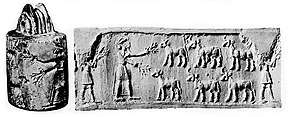
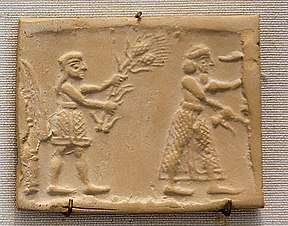
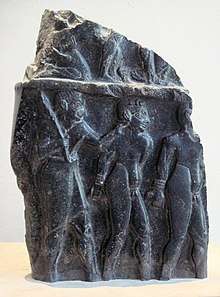
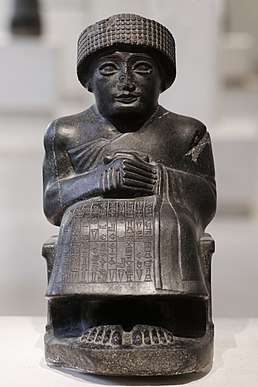
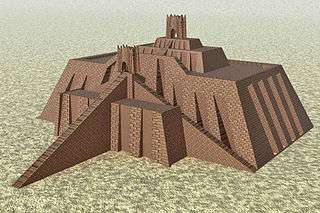


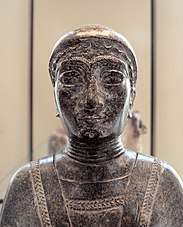
.jpg)
.jpg)

